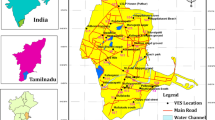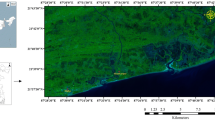Abstract
Recently, the deterioration of water quality in the coastal zones of Lekki Peninsula area of Lagos due to saltwater infiltration into the freshwater aquifer has become a major concern. With the aim of providing valuable information on the hydrogeologic system of the aquifers, the subsurface lithology and delineating the groundwater salinity, vertical electrical resistivity (VES) sounding survey was carried out utilizing surface Schlumberger electrode arrays, and electrode spacing varying between 1 and 150m. The DC resistivity surveys revealed significant variations in subsurface resistivity. Also, the VES resistivity curves showed a dominant trend of decreasing resistivity with depth (thus increasing salinity). In general, the presence of four distinct resistivity zones were delineated viz.: the unconsolidated dry sand (A) having resistivity values ranging between 125 and 1,028Ωm represent the first layer; the fresh water-saturated soil (zone B) having resistivity values which correspond to 32–256Ωm is the second layer; the third layer (zone C) is interpreted as the mixing (transition) zone of fresh with brackish groundwater. The resistivity of this layer ranges from 4 to 32Ωm; while layer four (zone D) is characterized with resistivities values generally below 4Ωm reflecting an aquifer possibly containing brine. The rock matrix, salinity and water saturation are the major factors controlling the resistivity of the formation. Moreover, this investigation shows that saline water intrusion into the aquifers can be accurately mapped using surface DC resistivity method.





Similar content being viewed by others
References
Abdul Nassir SS, Loke MH, Lee CY, Nawawi MNM (2000) Salt-water intrusion mapping by geoelectrical imaging surveys. Geophys Prospect 48:647–661
Adepelumi AA, Olorunfemi MO (2000) Engineering geological and geophysical investigation of the reclaimed Lekki Peninsula, Lagos southwest Nigeria. Bull Eng Geol Environ 58:125–132
Adepelumi AA, Yi MJ, Kim JH, Ako BD, Son JS (2006) Integration of surface geophysical methods for fracture detection in crystalline bedrocks of southwestern Nigeria. Hydrogeol J 14:1284–1306
Barret B, Heinson G, Hatch M, Telfer A (2002) Geophysical methods in saline groundwater studies: locating perched water tables and fresh-water lenses. Explor Geophys 33:115–121
Batayneh AT (2006) Use of electrical resistivity methods for detecting subsurface fresh and saline water and delineating their interfacial configuration: a case study of the eastern Dead Sea coastal aquifers. Jordan Hydrogeol J 14:1277–1283
Choudhury K, Saha DK, Chakraborty P (2001) Geophysical study for saline water intrusion in a coastal alluvial terrain. J Appl Geophys 46:189–200
Ginzburg A, Levanon A (1976) Determination of a saltwater interface by electric resistivity depth soundings. Hydrogeol Sci 21:561–568
Goldman M, Gilad D, Rouen A, Melloul A (1991) Mapping of seawater intrusion into the coastal aquifer of Israel by the time domain electromagnetic method. Geoexploration 28:153–174
Kingston DR, Dishroon CP, Williams PA (1983) Global basin classification system. Am Assoc Pet Geol 67:2175–2193
Lee CH, Chang TS (1974) On sea water encroachment in coastal aquifers. Water Resour Res 10:1039–1043
Lee JY, Song SH (2007) Evaluation of groundwater quality in coastal areas: implications for sustainable agriculture. Environ Geol 52(7):1231–1242
Longe EO, Malomo S, Olorunniwo MA (1987) Hydrogeology of Lagos Metropolis. Afr J Earth Sci 6(2):163–174
Nowroozi AA, Horrocks SB, Henderson P (1999) Saltwater intrusion into the freshwater aquifer in the eastern shore of Virginia: a reconnaissance electrical resistivity survey. J Appl Geophys 42:1–22
Oteri AU (1988) Electric Log Interpretation for the evaluation of salt water intrusion in the eastern Niger Delta. Hydrol Sci J 33(2):19–30
Pirttijärvi M (2005) DCINV: 1-D interpretation of electrical (DC) soundings software. Oulu, Finland
Pugh JC (1954) A classification of the Nigerian coastline. J West Afr Sci Assoc 1:3–12
Tsourlos P, Szymanski J, Tsokas G (1998) A smoothness constrained algorithm for the fast 2D inversion of DC resistivity and induced polarization data J Balkan Geophys Soc 1:3–13
UNDP (2006) Country evaluation: assessment of development results of Nigeria, pp 1–80
Winglink (2007) Integrated interpretation software. Version 2.20.01. Geosystem corporation, Milan
Author information
Authors and Affiliations
Corresponding author
Rights and permissions
About this article
Cite this article
Adepelumi, A.A., Ako, B.D., Ajayi, T.R. et al. Delineation of saltwater intrusion into the freshwater aquifer of Lekki Peninsula, Lagos, Nigeria. Environ Geol 56, 927–933 (2009). https://doi.org/10.1007/s00254-008-1194-3
Received:
Accepted:
Published:
Issue Date:
DOI: https://doi.org/10.1007/s00254-008-1194-3




